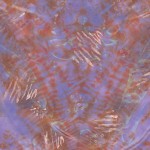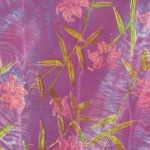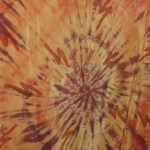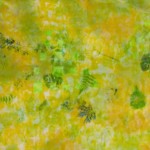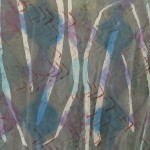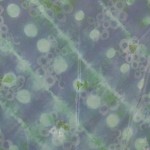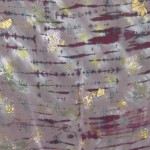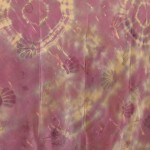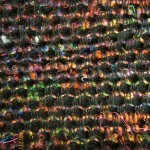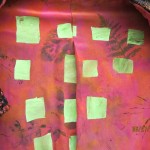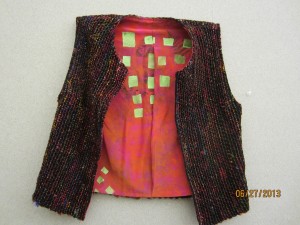In the fall of 2011, 10 members of the Yokayo Textile Guild led by member Jane Spanbauer, decided to try an ‘Art Cloth Round Robin’ . The idea for these round robins grew out of Jane Dunnewold’s book “Complex Cloth’ and the guidelines are on her website: www.artclothstudio.com
This was a 10 month project. The members divided into 2 groups of 5 and each person started with a white 36” x 50” piece of 16mm silk crepe de chine (www.jacquardproducts.com/products). Each cloth also had an associated folder which went with the cloth as it passed to each of the 5 members of the group. The folder contained specific details of each person’s embellishment and a picture of each layer so that there would be a complete record of how this art cloth went from plain to spectacular.
The first 2 layers were mainly dyeing and manipulation to create pattern & depth through overdyeing, resists and folding. The middle layers built on what had gone before with more dye,discharge, printing with textile paint and more. The final layer created a focal point or added a series of accents to the piece with foiling, stitching, beads, more paint and anything else you could think of. Each member had 2 months to work on a step before passing the cloth & folder on for the next layer. The passing was done after the guild meeting so all of the guild members were able to see the progress even if they weren’t involved in the process. It was very inspiring!
Jane’s guidelines are very specific and detailed (see website above) so instead of reproducing them, I thought it would be interesting to get the members thoughts on the project. There were some surprises. Many of the Art Cloth Round Robins are done through the internet with each person mailing their cloth to the next person after each step. The only way they may know the others involved is through a yahoo or google group.
Since ours was done within a guild where everyone knows each other and there are friendships of long standing, some participants were intimidated when following someone they felt was more experienced or “better at surface design”. There was also a concern that someone’s feelings would be hurt if their design was obliterated in the next step. Every member felt that it was a fun, challenging and interesting project. As we had a range of expertise from ‘never dyed before’ to people who sell their dyed & designed art work, there was a big learning curve for the beginners and some frustration for the more experienced. Being too specific and pictorial in the beginning stage made it more difficult at the next level.
All of the guild, participants or just admirers, loved seeing these inspiring pieces come together. The participants were:
Holly Brackmann, Sylvia Byczynski, Daphne Gillen-Alexander, Laurie Howard, Teryl Madlem, Lois Schaer, Cheryl Thompson, Jane Spanbauer, Dorothy Stebbins, and Marge van Dusen.
Now, what do I DO with that Art Cloth???
When Teryl Madlem received her finished piece of Art Cloth it was not in a colorway she loved… Overdyeing was the answer. Teryl used ‘chinese red’ Procion dye and the green and yellow was magically transformed into an orange and pinky red background with black and chartreuse accents. The chartreuse squares showed up because they were stenciled on the art cloth with an iridescent paint so the over dyeing did not affect them.
As a matter of fact now you really appreciated them where before they barely registered. Teryl also had a piece of material she had woven combining a black 10/2 cotton warp & weft and a reclaimed sari silk pattern weft using a honeycomb draft. The two pieces went together beautifully and a new piece of wearable art was born.
